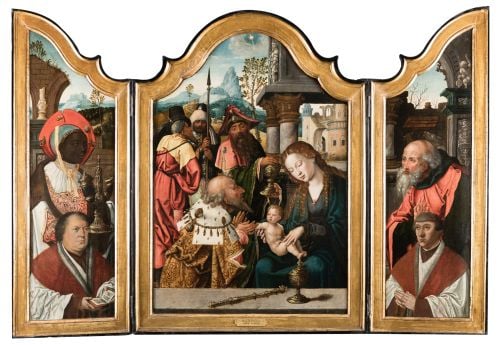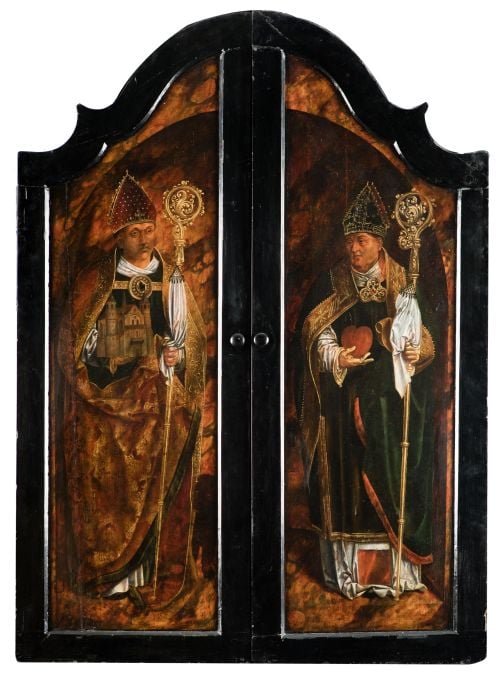Lot 144
PIETER COECKE VAN AELST (PIERRE COECK) Aelst, Bélgica (150
“Altarpiece of the Adoration of the Magi with donors”, 1528
Oil on oak panel.
Provenance:
Frances Amherst; Bishop of Northhampton; Monsignor Joseph Canon Burcke JLC; St. Bede's College, Manchester; Private collection, Madrid.
Bibliography:
Christa Grössinger, North-European panel Painters. A catalog of Netherlandish & German paintings before 1600 in English churches & colleges, London, 1992, pp. 150-152, no. 39, figs. 138, 140, 141; Kurt Löcher, Ein niederländischer Dreikönigs altar des 16. Jahrhunderts imKölner Dom und verwandete Alterretablen in Kölner Kirchen, Kölner Comblatt. Jahbuch des Zentral-Dombau-Vereins 67, 2002, pp. 212-213, fig. 12.
At the beginning of the 16th century, the city of Antwerp experienced very rapid growth that would Late up making it the most important cultural and commercial center north of the Alps. This was due to different factors such as, for example, the high number of potentially rich and prosperous clients and patrons who had settled in the city and also due to the export of works and the local market. The lack of a strong pictorial tradition, the liberal norms of the city's painters' guild, as well as the presence of artists from various schools, turned this enclave into a cultural melting pot with a high production of composite altarpieces, triptychs, diptychs and everything. type of paintings with a religious theme.
This important work, painted in 1528 by the young Pieter Coecke van Aelst, is an example that perfectly illustrates the cultural and artistic effervescence of the city of Antwerp in the first third of the 16th century. Following the usual practice at the time, he was inspired by a model that had enjoyed great fortune: an original composition created by the Master of 1518, the name given in 1915 by Max Friedländer to the painter of the Altarpiece of the Life of the Virgin of the Church of Saint Mary of Lübeck in Germany. There are different versions of this from his workshop, preserved in different places such as: the Museum of Fine Arts of Asturias; Johann Peter Weyer collection from Cologne; Galleria Regionale de Palermo or the one that was in the "Viuda de Cervera" collection in Cadiz. Another version, made by an unknown painter, is located in the Lazaro Galdiano Museum in Madrid and in the Galleria Rob Smeets in Milan and on the property of Jackson Higgs, in New York, two versions attributed to the hand of the Master of the Adoration of Lille.
The specialist Peter van der Brink studied this work in depth, assigning it to the painter Pieter Coecke van Aelst, pointing out that, among all the triptychs mentioned above, it is the only one that is dated and presents extraordinary quality, both in the elaboration of the figures and in the execution of architectures.Its formal characteristics fit perfectly with other works made by Coecke in his early period, such as the different representations of the Last Supper dated 1529, 1530 and 1531. Löcher, in the study of this work published in 2002, indicated by far It is true that the donors were painted in a second phase, following a procedure quite common in works of this typology, as were the figures of Saint Augustine and Saint Ambrose on the external faces. The studies carried out with infrared indicate that the specialist was correct since the portraits were painted on the figures, already completely finished, of King Baltasar and Saint Joseph. Its execution took place shortly after the altarpiece was completed, in Cologne, around the year 1530, possibly by Bartholomeus Bruyn the Younger. The fantastic altarpiece, as indicated by the specialists who have dedicated themselves to its study, was bought on the free market of Antwerp in Our Lady's Pand, probably by an abbot of the Augustinian order who had his portrait painted in the left wing by Bruyn. The presence on the external faces of the doors of Saint Augustine, as patron of the order, and Saint Ambrose, his mentor, also reinforce this origin. Attached is a study of the work carried out by the specialist Peter van den Brink.
Measurements: 106.5 x 73 cm. (Center panel); 105.5 x 31 cm. (At)
Starting price 300.000 €
Recomended lots
Confirm
You are bidding €
At the time of auction we will contact you by phone:
You accept the conditions of the room by confirming your bid
Loading…
Conecting with the server
Are you sure you want to buy the lot?




